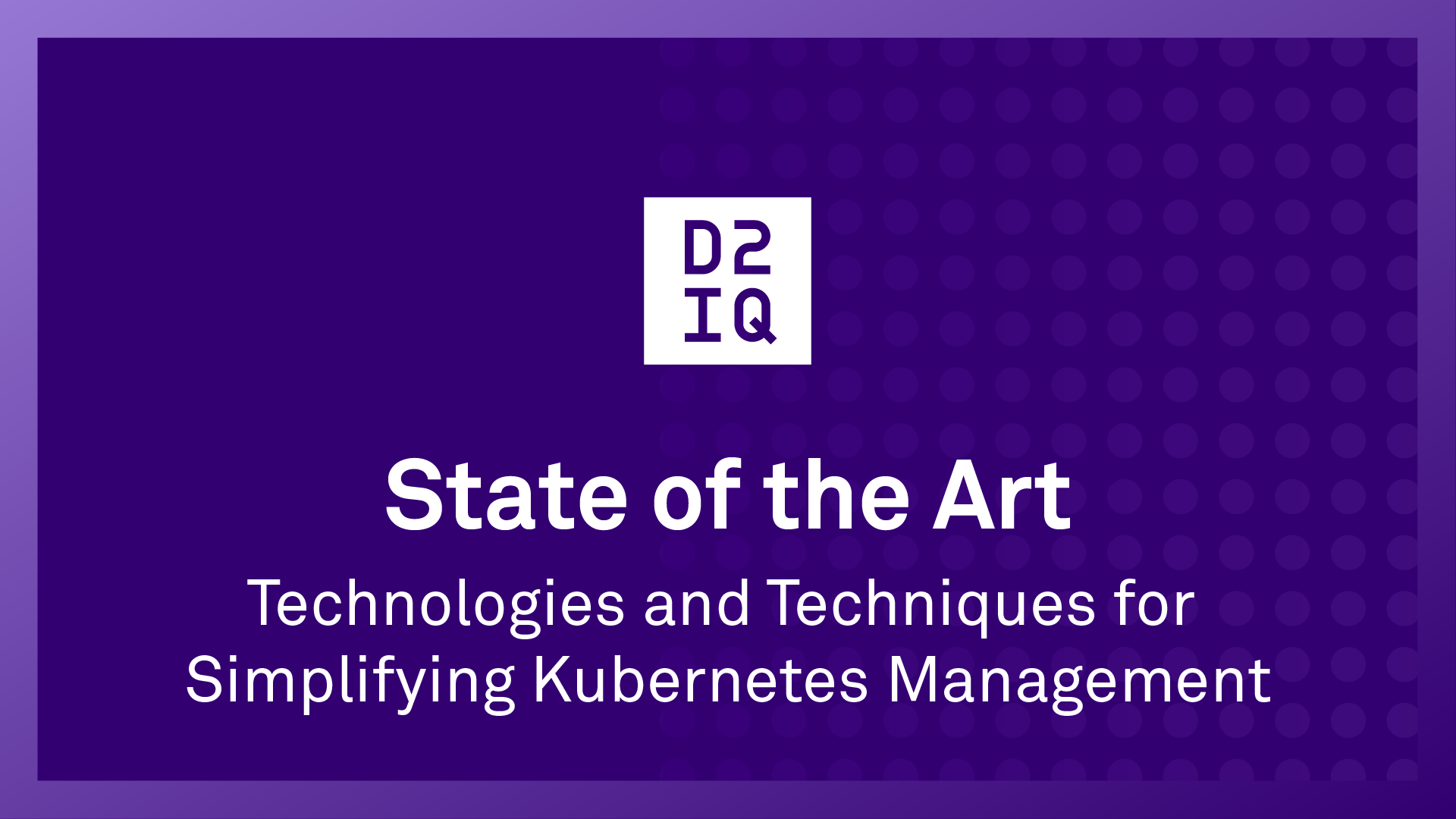Technologies and Techniques for Simplifying Kubernetes Management

10 min read
Speak with the Kubernetes experts at D2iQ.
With a wealth of cloud-native and Kubernetes survey findings to examine, and with KubeCon Europe 2023 fast approaching, it is a good time to take stock of the state of Kubernetes deployment and the strides that have been made to simplify Kubernetes management.
Surveys show that the top challenges organizations face in deploying Kubernetes and cloud-native technologies are complexity, security, and a skills gap. The latest CNCF annual survey, for example, found that lack of training was the most significant barrier inhibiting container adoption. The Pepperdata State of Kubernetes 2023 report found that the top Kubernetes challenges included a “steep learning curve,” while the Flexera 2023 State of the Cloud report found that the top challenges for cloud computing included “lack of expertise.”
The Kubernetes community has been hard at work to overcome these challenges, and a number of key technologies and techniques have been developed to simplify Kubernetes management. Let’s take a look.
Advancing the Art of Kubernetes Management
Among the most innovative technologies that have emerged to simplify the management of Kubernetes deployments are Cluster API (CAPI) and Flux. Among the most innovative techniques that have emerged to simplify, secure, and control the cost of Kubernetes deployments are GitOps, DevSecOps, FinOps, platform engineering, centralized fleet management, zero trust, and air-gapped approaches.
A wealth of wisdom has been dispensed by D2iQ experts to help organizations employ these technologies and techniques to overcome the challenges associated with deploying and managing Kubernetes. Following is a roundup of articles, briefs, tutorials, and webinars that can help you overcome challenges of Kubernetes management and avoid the pitfalls that lead to failure.
CAPI + GitOps = Kubernetes Done Right
Cluster API (CAPI) simplifies and brings consistency to Kubernetes management, while Flux provides similar benefits as the basis for GitOps workflow. The combination of CAPI and GitOps is so important that we coined the maxim “Declarative APIs + GitOps = Kubernetes Done Right.” CAPI and GirOps also enable you to overcome the skills gap by simplifying Kubernetes management. Articles that explain the capabilities and importance of CAPI and GitOps include:
- The Business Case for CAPI
- Introduction to Cluster API
- D2iQ + GitLab: Deliver Better Code Faster
- Kubernetes-as-a-Service with GitOps
Instant Platform Engineering
Platform engineering has become one of the hottest Kubernetes and cloud-native management trends. DKP is designed around Cluster API, which together with GitOps workflow enables DKP to provide instant platform engineering. This simplifies Kubernetes platform management, enabling you to manage a fleet of clusters across multiple infrastructure providers with a consistent API. This is superior to solutions that use infrastructure-specific, imperative, and brittle scripted deployments. Articles that explain the power of instant platform engineering include:
- Instant Kubernetes Platform Engineering for the Cloud
- Simplifying DevSecOps Through Platform Engineering
- All Together Now: FinOps, Kubernetes, and Platform Engineering
Tighter Security Through Zero Trust and Air-Gapping
Zero trust is overtaking “trust but verify” as a way to create stricter levels of security. Air-gapping can provide the highest level of security by isolating sensitive information from the Internet and restricting access. These resources provide excellent guidance on zero trust and air-gapping in Kubernetes environments:
- Elevate Kubernetes Security with Zero Trust
- Zero Trust for Kubernetes Environments
- Overcoming Challenges of Air-Gapped Kubernetes
- SAIC Shares Military Grade Kubernetes Best Practices for Digital Transformation
Eliminating Wasteful Spending
The inability to monitor and control cloud and Kubernetes costs is an oft-cited challenge. Surveys show that 30% to 40% of cloud spending is wasted. Here too, technologies and techniques provide ways to control costs and eliminate waste.
- The Best Way to Control Kubernetes and Cloud Costs
- Taming Cloud and Kubernetes Costs Through FinOps
- Are You One of the 67% Failing in the Cloud? How to Do Kubernetes Right
The Importance of Pure CNCF-Conformant Kubernetes
Another way to simplify Kubernetes management and avoid security, upgradeability, portability, and other problems is to deploy a Kubernetes management platform based on pure upstream CNCF-conformant Kubernetes.
Want to learn how D2iQ can help you overcome all of these Kubernetes management challenges? The D2iQ Maturity Assessment tool can help you gauge where you are on the Kubernetes maturity curve and help you reap the greatest benefits at each maturity.
Want to learn how you can overcome Kubernetes management challenges? Take the opportunity to tap into the wisdom of the Kubernetes experts at D2iQ.







